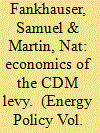| Srl | Item |
| 1 |
ID:
097338


|
|
|
|
|
| Publication |
2010.
|
| Summary/Abstract |
This paper analyses the design of carbon markets in space (i.e., geographically). It is part of a twin set of papers that, starting from first principles, ask what an optimal global carbon market would look like by around 2030. Our focus is on firm-level cap-and-trade systems, although much of what we say would also apply to government-level trading and carbon offset schemes. We examine the "first principles" of spatial design to maximise flexibility and to minimise costs, including key design issues in linking national and regional carbon markets together to create a global carbon market.
|
|
|
|
|
|
|
|
|
|
|
|
|
|
|
|
| 2 |
ID:
097333


|
|
|
|
|
| Publication |
2010.
|
| Summary/Abstract |
This paper analyses the design of carbon markets in time (i.e., intertemporally). It is part of a twin set of papers that ask, starting from first principles, what an optimal global carbon market would look like by around 2030. Our focus is on firm-level cap-and-trade systems, although much of what we say would also apply to government-level trading and carbon offset schemes. We examine the "first principles" of temporal design that would help to maximise flexibility and to minimise costs, including banking and borrowing and other mechanisms to provide greater carbon price predictability and credibility over time.
|
|
|
|
|
|
|
|
|
|
|
|
|
|
|
|
| 3 |
ID:
093507


|
|
|
|
|
| Publication |
2010.
|
| Summary/Abstract |
A levy on the Clean Development Mechanism and other carbon trading schemes is a potential source of finance for climate change adaptation. An adaptation levy of 2% is currently imposed on all CDM transactions which could raise around $500 million between now and 2012. This paper analyses the scope for raising further adaptation finance from the CDM, the economic costs (deadweight loss) of such a measure and the incidence of the levy, that is, the economic burden the levy would impose on the buyers and sellers of credits. We find that a levy of 2% could raise up to $2 billion a year in 2020 if there are no restrictions on demand. This could rise to $10 billion for a 10% tax. Restrictions on credit demand (called supplementarity limits, the requirement that most emission abatement should happen domestically) curtail trade volumes and consequently tax revenues. They also alter the economic impact of the CDM levy. Without supplementarity restrictions sellers (developing countries) bear two-thirds of the cost of the tax. If there are supplementarity limits they can pass on the tax burden to buyers (developed countries) more or less in full. Without supplementarity restrictions the distortionary effect of the levy (its deadweight loss) rises sharply with the tax rate. With them the deadweight loss is close to zero.
|
|
|
|
|
|
|
|
|
|
|
|
|
|
|
|